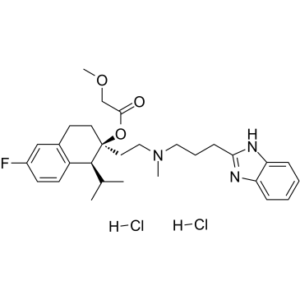Mibefradil dihydrochloride
This product is for research use only, not for human use. We do not sell to patients.

For small sizes, please check our retail website as below: www.invivochem.com
| Size | Price | Stock |
|---|---|---|
| 250mg | $1450 | Check With Us |
| 500mg | $2100 | Check With Us |
| 1g | $3150 | Check With Us |
Cat #: V33725 CAS #: 116666-63-8 Purity ≥ 99%
Description: Mibefradil dihydrochloride (Ro 40-5967; trade name: Posicor), the dihydrochloride salt of miberfradil, is a CCB/calcium channel blocker with anti-hypertensive activity.
Top Publications Citing Invivochem Products
Publications Citing InvivoChem Products
Product Promise

- Physicochemical and Storage Information
- Protocol
- Related Biological Data
- Stock Solution Preparation
- Quality Control Documentation
| Molecular Weight (MW) | 568.55 |
|---|---|
| Molecular Formula | C₂₉H₄₀Cl₂FN₃O₃ |
| CAS No. | 116666-63-8 |
| Protocol | In Vitro | Mibefradil inhibits reversibly the T- and L-type currents with IC50 values of 2.7 and 18.6 μM, respectively. The inhibition of the L-type current is voltage-dependent, whereas that of the T-type current is not. Ro 40-5967 blocks T-type current already at a holding potential of -100 mV[1] At a higher concentration (20 µM), Mibefradil reduces the amplitude of excitatory junction potentials (by 37±10 %), slows the rate of repolarisation (by 44±16 %) and causes a significant membrane potential depolarisation (from −83±1 mV to −71±5 mV). At a higher Mibefradil concentration (20 µM) there is significant membrane potential depolarisation and a slowing of repolarisation. These actions of Mibefradil are consistent with K+ channel inhibition, which has been shown to occur in human myoblasts and other cells. |
|---|---|---|
| In Vivo | The hearing thresholds of the 24-26 week old C57BL/6J mice differ following the 4-week treatment period. The hearing threshold at 24 kHz is significantly decreased in the Mibefradil-treated and benidipine-treated groups compared with the saline-treated group (P<0.05) |
These protocols are for reference only. InvivoChem does not
independently validate these methods.
| Solvent volume to be added | Mass (the weight of a compound) | |||
|---|---|---|---|---|
| Mother liquor concentration | 1mg | 5mg | 10mg | 20mg |
| 1mM | 1.7589 mL | 8.7943 mL | 17.5886 mL | 35.1772 mL |
| 5mM | 0.3518 mL | 1.7589 mL | 3.5177 mL | 7.0354 mL |
| 10mM | 0.1759 mL | 0.8794 mL | 1.7589 mL | 3.5177 mL |
| 20mM | 0.0879 mL | 0.4397 mL | 0.8794 mL | 1.7589 mL |
The molarity calculator equation
Mass(g) = Concentration(mol/L) × Volume(L) × Molecular Weight(g/mol)
Mass
=
Concentration
×
Volume
×
Molecular Weight*
The dilution calculator equation
Concentration(start)
×
Volume(start)
=
Concentration(final)
×
Volume(final)
This equation is commonly abbreviated as: C1 V1 = C2 V2
Concentration(start)
C1
×
Volume(start)
V1
=
Concentration(final)
C2
×
Volume(final)
V2
Step One: Enter information below
Dosage mg/kg
Average weight of animals g
Dosing volume per animal µL
Number of animals
Step Two: Enter the in vivo formulation
%DMSO
+
%
+
%Tween 80
+
%ddH2O
Calculation Results:
Working concentration:
mg/ml;
Method for preparing DMSO master liquid:
mg
drug pre-dissolved in
µL
DMSO(Master liquid concentration
mg/mL)
,Please contact us first if the concentration exceeds the DMSO solubility of the batch of drug.
Method for preparing in vivo formulation:
Take
µL
DMSO master liquid, next add
µL
PEG300, mix and clarify, next add
µL
Tween 80,mix and clarify, next add
µL
ddH2O,mix and clarify.
Note:
- (1) Please be sure that the solution is clear before the addition of next solvent. Dissolution methods like vortex, ultrasound or warming and heat may be used to aid dissolving.
- (2) Be sure to add the solvent(s) in order.




































